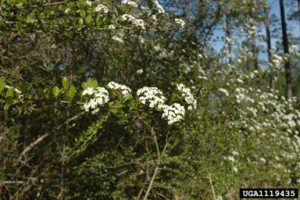Viburnum obovatum is sometimes referred to as Walter’s viburnum in reference to Thomas Walter of South Carolina who described the species in his Flora Caroliniana in the 1700’s.
Viburnum obovatum is native to U.S. and is in the Caprifoliaceae (Honeysuckle Family)
Photo Credit: © Chris Evans, River to River CWMA, Bugwood.org
Viburnum obovatum
Common Name: small-leaf arrowwood
Other Common Names: walter viburnum, Walter's viburnum
Plant Functional Group: Evergreen broadleaf
Class > Order > Family: Magnoliopsida > Dipsacales > Adoxaceae
What does the species look like?
Viburnum obovatum is a semi-evergreen, evergreen, shrub or small tree growing to 12 to 20 or more feet in height. Small-leaf arrowwood usually has a broad spreading crown and multiple gray-barked trunks. Its leaves are small, shiny, dark green and wedge shaped. Flowers are white, fragrant and showy. Its fruit is a small berry like drupe which starts out red and turns shiny blue-black when mature.
Viburnum obovatum grows in wet hammocks, thickets, swamp margins and near streams. It has low to moderate tolerance to drought and is cold tolerant. It prefers full sun but tolerates part shade. Small-leaf arrow can tolerate a variety of soils, but prefers moist to wet soils. Birds and other animals eat the fruit of small-leaf arrow. It is a good nectar plant for butterflies. Cardinals and other songbirds use the foliage for nesting. Bees are also attracted to the flowers of small-leaf arrow. Some consider it a good specimen for landscape plantings
Where is the species found?
States & Provinces
AL, FL, GA, SC
Special Considerations for Observing
If drought seems to be the cause of leaf color or fall for a plant, please make a comment about it for that observation.
Which phenophases should I observe?
Do you see...?
Leaves
Breaking leaf buds More...
How many buds are breaking?
Less than 3 3 to 10 11 to 100 101 to 1,000 1,001 to 10,000 More than 10,000
Young leaves How many young leaves are present?
Less than 3 3 to 10 11 to 100 101 to 1,000 1,001 to 10,000 More than 10,000
Flowers
Flowers or flower buds More...
How many flowers and flower buds are present? For species in which individual flowers are clustered in flower heads, spikes or catkins (inflorescences), simply estimate the number of flower heads, spikes or catkins and not the number of individual flowers.
Less than 3 3 to 10 11 to 100 101 to 1,000 1,001 to 10,000 More than 10,000
Open flowers More...
What percentage of all fresh flowers (buds plus unopened plus open) on the plant are open? For species in which individual flowers are clustered in flower heads, spikes or catkins (inflorescences), estimate the percentage of all individual flowers that are open.
Less than 5% 5-24% 25-49% 50-74% 75-94% 95% or more
Fruits
Fruits Viburnum obovatum , the fruit is a berry that changes from green to red or black.More...
How many fruits are present?
Less than 3 3 to 10 11 to 100 101 to 1,000 1,001 to 10,000 More than 10,000
Ripe fruits Viburnum obovatum , a fruit is considered ripe when it has turned red or black.More...
What percentage of all fruits (unripe plus ripe) on the plant are ripe?
Less than 5% 5-24% 25-49% 50-74% 75-94% 95% or more
Recent fruit or seed drop More...
How many mature fruits have dropped seeds or have completely dropped or been removed from the plant since your last visit?
Less than 3 3 to 10 11 to 100 101 to 1,000 1,001 to 10,000 More than 10,000
What do these phenophases look like?
There is currently no photoguide available for this species. If you'd like help us create one, use the guidance document and species template provided here . Then send it via email to education@usanpn.org when it is complete.
